Related Research Articles
21 Cancri is a double star in the northern zodiac constellation of Cancer. It is just visible to the naked eye as a dim, red-hued star with an apparent visual magnitude of 6.08. The star is located around 791 light years away from the Sun, based on parallax. It is moving further from the Earth with a heliocentric radial velocity of 35 km/s.
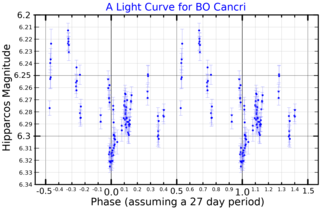
53 Cancri is a variable star in the zodiac constellation Cancer, located around 960 light years from the Sun. It has the variable star designation BO Cancri; 53 Cancri is the Flamsteed designation. This object is a challenge to view with the naked eye, having an apparent visual magnitude around 6. It is around 960 light years away.

Omicron Cassiopeiae is a triple star system in the constellation Cassiopeia. It is approximately 700 light-years from Earth, based on its parallax. It is visible to the naked eye with a slightly variable apparent magnitude of about 4.5.
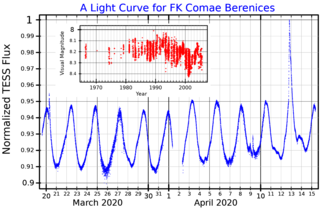
FK Comae Berenices is a variable star that varies in apparent magnitude between 8.14 and 8.33 over a period of 2.4 days. It is the prototype for the FK Comae Berenices class of variable stars. The variability of FK Com stars may be caused by large, cool spots on the rotating surfaces of the stars. This star is thought to be the result of a recent binary merger, resulting in a high rate of both spin and magnetic activity.

V385 Andromedae is a variable star in the constellation Andromeda, about 360 parsecs (1,200 ly) away. It is a red giant over a hundred times larger than the sun. It has an apparent magnitude around 6.4, just about visible to the naked eye in ideal conditions.

LP Aquarii is a pulsating variable star in the constellation of Aquarius that varies between magnitudes 6.30 and 6.64. The position of the star near the ecliptic means it is subject to lunar occultations.

HD 155035 is the Henry Draper Catalogue designation for a star in the constellation Ara, the Altar. It is located at a distance of approximately 1,450 light-years from Earth and has an apparent visual magnitude of 5.92, making it is faintly visible to the naked eye. This is a red giant star with a stellar classification of M1.5 III. It an irregular variable that changes brightness over an amplitude range of 0.12 magnitudes.
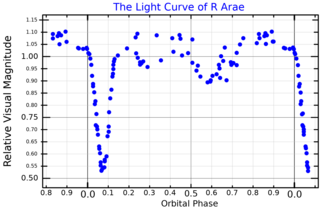
R Arae is an Algol-type eclipsing binary in the constellation Ara. Located approximately 298 parsecs (970 ly) distant, it normally shines at magnitude 6.17, but during eclipses can fall as low as magnitude 7.32. It has been suggested by multiple studies that mass transfer is occurring between the two stars of this system, and the period of eclipses seems to be increasing over time. The primary is a blue-white main sequence star of spectral type B5V that is 5 times as massive as the Sun, while the secondary is a yellow-white star of spectral type F1IV that is 1.5 times as massive as the Sun. Stellar material is being stripped off the secondary and accreting on the primary.
HD 36678 is single star in the northern constellation of Auriga. This star is dimly visible to the naked eye with an apparent visual magnitude of 5.83. It is located at a distance of approximately 840 light years from the Sun based on parallax.
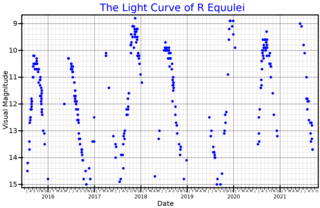
R Equulei is a class M Mira variable star in the constellation Equuleus. Its brightness varies between a minimum magnitude of 15.0 to a maximum of 8.7 with an average period of 261 days.
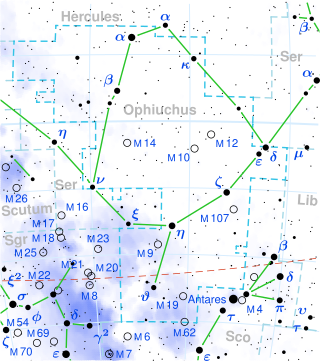
Sigma Ophiuchi, Latinized from σ Ophiuchi, is a single, orange-hued star in the equatorial constellation Ophiuchus. Its apparent visual magnitude is 4.31, which is bright enough to be faintly visible to the naked eye. The annual parallax shift of 3.62 mas as seen from Earth provides a distance estimate of roughly 900 light years. It is moving closer to the Sun with a radial velocity of −28 km/s.

V1073 Scorpii is a variable star in the constellation Scorpius. It has a non-Greek Bayer designation of k Scorpii. The star has a blue-white hue and is visible to the naked eye with an apparent visual magnitude that fluctuates around +4.87. Parallax measurements yield a distance estimate of approximately 2,920 ly (896 pc) from the Sun, and it is drifting further away with a radial velocity of +7 km/s. It has an absolute magnitude of −6.8
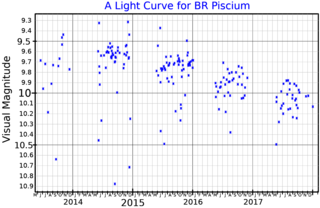
Gliese 908 is a red dwarf star, located in constellation Pisces at 19.3 light-years from Earth. It is a BY Draconis variable star with a variable star designation of BR Piscium. Its apparent magnitude varies between magnitude 8.93 and magnitude 9.03 as a result of starspots and varying chromospheric activity.
EQ Pegasi is a nearby binary system of two red dwarfs. Both components are flare stars, with spectral types of M4Ve and M6Ve respectively, and a current separation between the components of 5.8 arcseconds. The system is at a distance of 20.4 light-years, and is 950 million years old. The primary star is orbited by one known exoplanet.
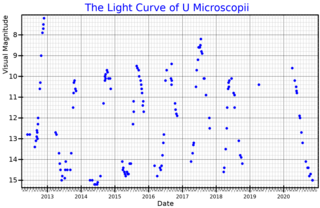
U Microscopii is a Mira variable star in the constellation Microscopium. It ranges from magnitude 7 to 14.4 over a period of 334 days. The Astronomical Society of Southern Africa in 2003 reported that observations of U Microscopii were very urgently needed as data on its light curve was incomplete.
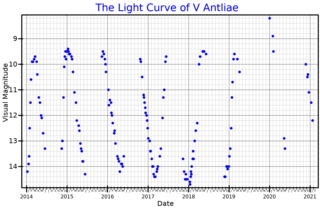
V Antliae is a Mira variable star in the constellation Antlia. It varies in brightness between magnitudes 8.2 and 14.0 with a period of 303 days.

HD 65750, also known as V341 Carinae is a bright red giant star in the constellation Carina. It is surrounded by a prominent reflection nebula, known as IC 2220, nicknamed the Toby Jug Nebula.

BO Carinae, also known as HD 93420, is an irregular variable star in the constellation Carina.
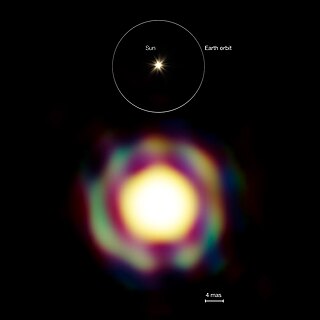
T Leporis is a variable star in the constellation of Lepus, the Hare. It is located half a degree from ε Leporis in the sky; its distance is approximately 1,100 light years from the Solar System. It has the spectral type M6ev, and is a Mira variable — as is R Leporis, in the same constellation — whose apparent magnitude varies between +7.40 and +14.30 with a period of 368.13 days.
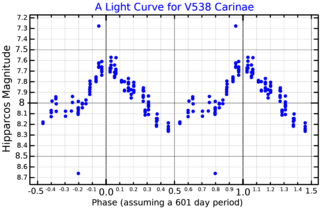
V538 Carinae is a variable star in the constellation of Carina, and a possible red supergiant. If this star replaced the Sun in the Solar System, its photosphere would at least engulf the orbit of Mars.
References
- 1 2 3 4 5 6 7 8 9 Brown, A. G. A.; et al. (Gaia collaboration) (August 2018). "Gaia Data Release 2: Summary of the contents and survey properties". Astronomy & Astrophysics . 616. A1. arXiv: 1804.09365 . Bibcode: 2018A&A...616A...1G . doi: 10.1051/0004-6361/201833051 . Gaia DR2 record for this source at VizieR.
- ↑ Høg, E.; Fabricius, C.; Makarov, V. V.; Urban, S.; Corbin, T.; Wycoff, G.; Bastian, U.; Schwekendiek, P.; Wicenec, A. (2000). "The Tycho-2 catalogue of the 2.5 million brightest stars". Astronomy and Astrophysics. 355: L27. Bibcode:2000A&A...355L..27H.
- ↑ Houk, N.; Cowley, A. P. (1975). University of Michigan Catalogue of two-dimensional spectral types for the HD stars. Volume I. Declinations -90_ to -53_ƒ0. Bibcode:1975mcts.book.....H.
- ↑ Samus, N. N.; Durlevich, O. V.; et al. (2009). "VizieR Online Data Catalog: General Catalogue of Variable Stars (Samus+ 2007-2013)". VizieR On-line Data Catalog: B/GCVS. Originally Published in: 2009yCat....102025S. 1: B/gcvs. Bibcode:2009yCat....102025S.
- ↑ Anderson, E.; Francis, Ch. (2012). "XHIP: An extended hipparcos compilation". Astronomy Letters. 38 (5): 331. arXiv: 1108.4971 . Bibcode:2012AstL...38..331A. doi:10.1134/S1063773712050015. S2CID 119257644.
- ↑ Kervella, Pierre; Arenou, Frédéric; Mignard, François; Thévenin, Frédéric (2019). "Stellar and substellar companions of nearby stars from Gaia DR2. Binarity from proper motion anomaly". Astronomy and Astrophysics. 623: A72. arXiv: 1811.08902 . Bibcode:2019A&A...623A..72K. doi:10.1051/0004-6361/201834371. S2CID 119491061.
- ↑ Kunder, Andrea; Kordopatis, Georges; Steinmetz, Matthias; Zwitter, Tomaž; McMillan, Paul J.; Casagrande, Luca; Enke, Harry; Wojno, Jennifer; Valentini, Marica; Chiappini, Cristina; Matijevič, Gal; Siviero, Alessandro; De Laverny, Patrick; Recio-Blanco, Alejandra; Bijaoui, Albert; Wyse, Rosemary F. G.; Binney, James; Grebel, E. K.; Helmi, Amina; Jofre, Paula; Antoja, Teresa; Gilmore, Gerard; Siebert, Arnaud; Famaey, Benoit; Bienaymé, Olivier; Gibson, Brad K.; Freeman, Kenneth C.; Navarro, Julio F.; Munari, Ulisse; et al. (2017). "The Radial Velocity Experiment (RAVE): Fifth Data Release". The Astronomical Journal. 153 (2): 75. arXiv: 1609.03210 . Bibcode:2017AJ....153...75K. doi: 10.3847/1538-3881/153/2/75 . S2CID 118835808.
- ↑ De Medeiros, J. R.; Alves, S.; Udry, S.; Andersen, J.; Nordström, B.; Mayor, M. (2014). "A catalog of rotational and radial velocities for evolved stars. V. Southern stars". Astronomy and Astrophysics. 561: A126. arXiv: 1312.3474 . Bibcode:2014A&A...561A.126D. doi:10.1051/0004-6361/201220762. S2CID 54046583.
- ↑ "HR 4142". SIMBAD . Centre de données astronomiques de Strasbourg . Retrieved 31 August 2012.
- ↑ Sinachopoulos, D.; Gavras, P.; Dionatos, O.; Ducourant, Ch.; Medupe, Th. (2007). "CCD astrometry and components instrumental magnitude difference of 432 Hipparcos wide visual double stars". Astronomy and Astrophysics. 472 (3): 1055. Bibcode:2007A&A...472.1055S. doi: 10.1051/0004-6361:20066290 . hdl: 11427/35072 .
- ↑ Brown, A. G. A.; et al. (Gaia collaboration) (August 2018). "Gaia Data Release 2: Summary of the contents and survey properties". Astronomy & Astrophysics . 616. A1. arXiv: 1804.09365 . Bibcode: 2018A&A...616A...1G . doi: 10.1051/0004-6361/201833051 . Gaia DR2 record for this source at VizieR.